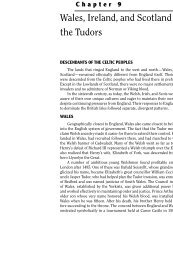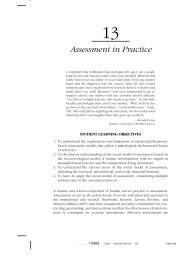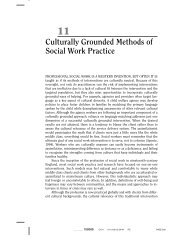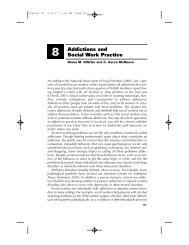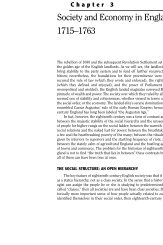Chapter 6 Medieval British Society, 1066–1485 - Lyceum Books
Chapter 6 Medieval British Society, 1066–1485 - Lyceum Books
Chapter 6 Medieval British Society, 1066–1485 - Lyceum Books
Create successful ePaper yourself
Turn your PDF publications into a flip-book with our unique Google optimized e-Paper software.
132 Part II Norman Britain<br />
The Church of St. Peter and St. Paul, Lavenham, Suffolk, one of England’s largest parish<br />
churches. Built in the Perpendicular style, this is an example of a “wool church”—one<br />
built by the wealth gathered through the wool trade.<br />
Reproduced by permission of the Royal Commission on the Historical Monuments of<br />
England.<br />
called Early English, since it exhibits certain features that are unique to the country.<br />
Salisbury Cathedral is perhaps the best example of an Early English cathedral,<br />
since it was constructed during a relatively short span of time and exhibits few<br />
features from any other period. It has large numbers of tall, narrow windows, called<br />
lancets because they resemble a surgeon’s instrument. Flying buttresses were used<br />
to help carry the weight of the stone vaults down to the ground. The buttresses<br />
made it possible to have thinner exterior walls, with more space given over to windows.<br />
The great spire of Salisbury, visible for miles around, was not part of the<br />
original plan but was added in the fourteenth century. Its weight created structural<br />
diffi culties that still present problems, but few would deny its exceptional beauty<br />
or its importance as a symbol of the cathedral’s presence. The cathedral at Wells, in<br />
southwest England, is notable for the three hundred magnifi cent statues carved in<br />
the thirteenth century to adorn its facade. Much of Westminster Abbey was rebuilt<br />
in the Early English style during the reign of Henry III. Lincoln Cathedral is another<br />
great edifi ce of this era.<br />
The earlier part of the fourteenth century saw the introduction of the Decorated<br />
style. Buildings of this age, like Exeter Cathedral and the choir of Wells, display larger<br />
windows with elaborate, fanciful patterns of stone tracery. More elaborate vaulting




